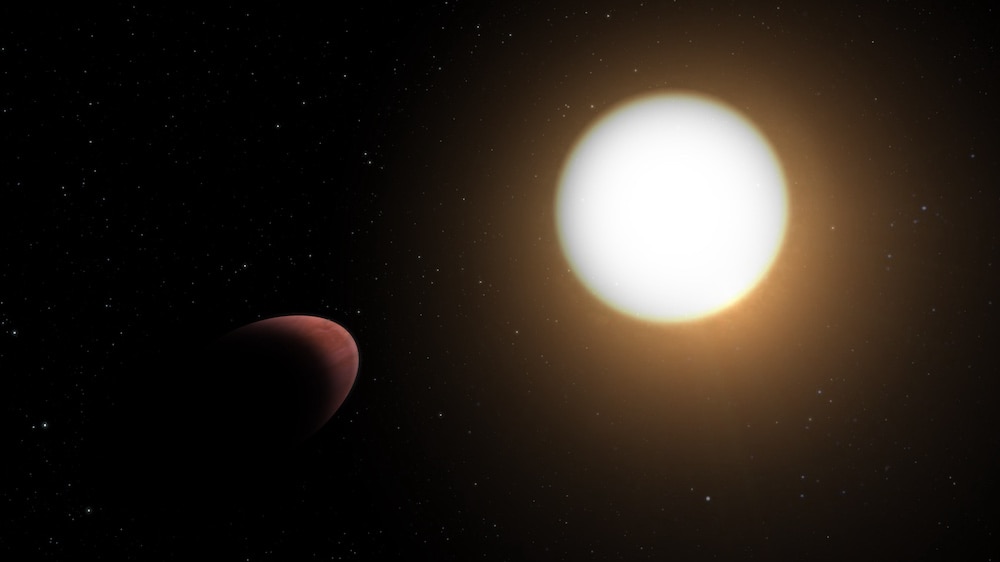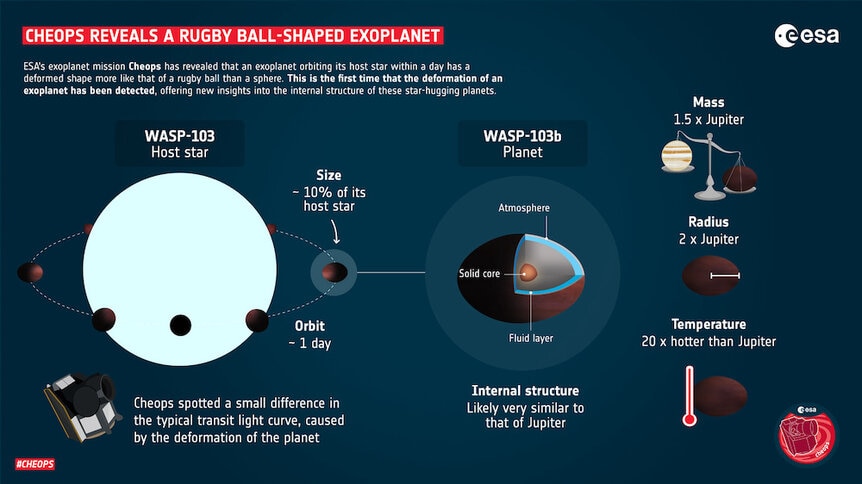Create a free profile to get unlimited access to exclusive videos, sweepstakes, and more!
CHEOPS reveals WASP-103b: An egg-shaped planet that's definitely hard boiled
WASP-103b is cooked and distorted by its host star.

The Earth isn't flat. But then it's not spherical, either. Not really. It spins, so it's a little bit flattened, wider through the middle than through the poles. The gravity of the Moon and Sun distort it a little bit, too.
But we have nothing on the exoplanet WASP-103b. The gravity from its host star has distorted the planet's shape so much it can be detected from Earth. The planet is extremely egg-shaped, and if you were there — which I wouldn't recommend, as I explain in a sec — you could easily see it.
The host star is called WASP-103 — the 103rd star found to host an exoplanet detected by the Wide-Angle Search for Planets survey — and is about 1,800 light years from Earth. It's bigger, more massive, and hotter than the Sun. It emits about 3.5 times as much light as the Sun does, so any planet there will get a face full of heat from it compared to one orbiting our Sun at the same distance.
The exoplanet WASP-103b was announced in 2014, and it is one of the most extreme planets we know. It's a super-Jupiter, with 1.5 times the mass of our biggest planet and also 1.5 times its diameter. If you think back to the dim reaches of high school you may remember that volume increases as the cube of the radius, so it actually has 1.53 = 3.4 times Jupiter's volume. So even though it has 50% more mass, it's actually a lot less dense than Jupiter, about half as much.
Why? Because WASP-103b is orbiting a mere 2 million kilometers above the surface of its host star! The amount of energy blasting it from the star is something like 10,000 times what the Earth receives, so the planet isn't much cooler than the star itself. That's why I'd recommend standing back if you want to visit: You'd be a thin vapor in short order.
All that extra heat has puffed the planet up, like a balloon inflating when heated, making it bigger than Jupiter. It also makes it more susceptible to tidal distortion, too.
WASP-103b is so close to its star, and so big, that the side of the planet facing the star is significantly closer than the side facing away. The force of gravity weakens rapidly with distance, so much so that the two sides of the planet feel a big difference in gravity from the star. The net effect of this is to stretch the planet, making it prolate, elongated like an American football (or more like a rugby ball). This change in gravity is what we call tides, so this is a tidal distortion.
The distortion can theoretically be detected by carefully examining the light from the planet as it orbits the star. It was detected in the first place because it transits the star, passing directly in front of it as seen from Earth, causing a mini-eclipse which dims the star a bit.
Here's the fun bit: Astronomers used the newly launched ESA CHEOPS — for CHaracterising ExOplanet Satellite — to very carefully examine 12 such transits of the planet (link to paper). When the planet is directly in front of the star we are looking at its night side. But as it continues moving around the star we see it go through phases, just like we do for the Moon; we see more of it lit by the star. After a quarter of its orbit we see it half-lit (like a first quarter Moon), then we see more and more of it lit until it passes behind the star, and we see a secondary transit as the star blocks the planet's light. Then it comes back around from behind the star and the phases reverse until it transits again.
This means the star + planet grow very slightly brighter in the first part of the planet's orbit, and dimmer in the second half. But the amount and rate it gets brighter doesn't really match a spherical planet. Instead, what's observed is better fit if the planet is elongated, egg-shaped, just like the theory predicts! This is the first time such a tidal distortion has been seen directly from brightness variations of an exoplanet.
In fact the amount it's distorted is partly determined by how stretchy the planet is. If it were solid metal, for example, it wouldn't get distorted much at all because metal is fairly rigid. If it's a liquid it distorts more, and gaseous even more — the tidal force from the Moon distorts the solid Earth, but not nearly as much as it does our watery liquid oceans.
The planet orbits the star very rapidly, taking only about 22 Earth-hours to circle it once. Its year is less than an Earth day! Because it's so close and moving so rapidly, it's expected that over time the tidal force acting on it from its star will steal orbital energy from it, causing its orbit to decay, to shrink. Over a long period of time, likely millions of years, it will eventually drop so close to its star that it will get torn apart.
However, no such decay was seen. In fact there's a hint that its orbit is getting bigger! That's the opposite of what's expected. That could be due to the influence of another planet or star — there's a marginal detection of a lower-mass companion star much farther out, though it's not conclusive if it's actually part of the system or not — or honestly it could just be a statistical artifact of the way they processed the data from CHEOPS, and not real.
Further observations may iron that out. In fact WASP-103b is a prime candidate for more observations with CHEOPS to measure the tidal distortion, and a transit or two seen by the James Webb Space Telescope would be even better. The amount the planet is distorted is related to its internal structure, and the astronomers were able to determine the planet likely has a rocky-metallic core, a layer of highly compressed gas above that which is more like a liquid, with an extended distorted atmosphere above that. It's a lot like Jupiter, really, except for the furnace-blast heat and tidal stretchiness.
The NASA Exoplanet Database lists nearly 4,900 confirmed exoplanets. Quite a few of them are just plain weird, and as we discover more that list will grow. WASP-103b is certainly one of the stranger planets found, and makes me wonder what other bizarre oddities we'll find as we continue to seek out strange, new worlds.




























